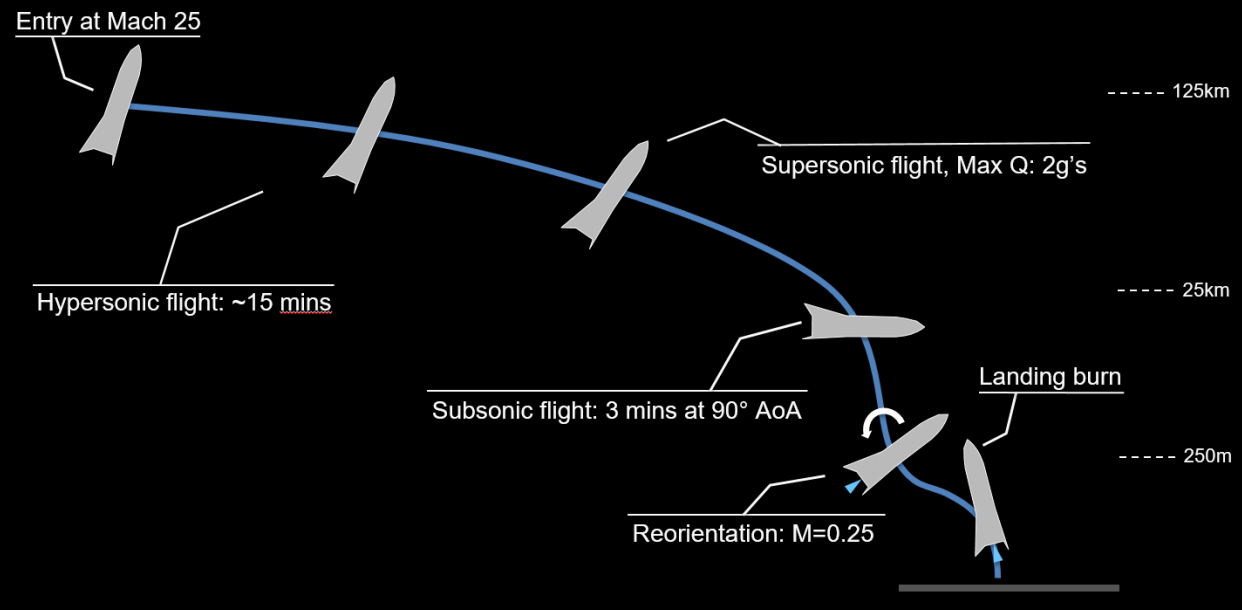Copyright 2019 Robert Clark
I remember thinking when reading of the debate about reusable vehicles between proponents of horizontal winged and vertical propulsive landing that all this debate was about a measly 100 m/s delta-v. The reason is whether you use wings or not almost all the speed of orbital velocity is going to be killed off aerodynamically on return. For even for vertical landing, the stage entering broadside will be slowed to terminal velocity, ca. 100 m/s. This is only about 1.3% that of orbital velocity of 7,800 m/s.
This was confirmed by a graphic just released by SpaceX about the BFR’s Starship upper stage reentry:
As discussed for example in this article:
Here is Elon also discussing how the Starship will land on Earth, including the low terminal velocity, and low final landing burn:
How SpaceX's BFR Rocket Will Land - Elon Musk Explains.
This shows for the Starship it only has to fire the engines at about Mach 0.25, 80 m/s. So it only has to kill off 80 m/s propulsively. But with the Starship just needing to kill off a 80 m/s velocity with a 3,300 m/s Raptor sea level exhaust velocity, about 330s Isp, by the rocket equation the mass ratio to do this is e[80/3300] = 1.025. Subtracting 1 from this is the ratio of the propellant required to the dry mass. The tanker version of the BFR upper stage, i.e., without the passenger quarters, will have a dry mass of ca. 50 tons (compared to the 85 tons of the Mars Colonial Starship version.) This means you only lose 1.25 tons for the landing.
But a rocket equation estimate using a 356 s vacuum Isp for the sea level raptors gives a ca. 40 ton payload for the tanker version as an SSTO.
See for example here:
Then the 1.25 tons lost due to propellant kept on reserve loses ca. 3% of the payload due just to the reserve propellant required. You also lose a proportion due to thermal protection system and landing legs but that’s also true for the TSTO.
However, because of the huge amount that needs to be kept on reserve for a first stage booster of a TSTO for slowing the booster down for reentry and for boost back to the launch site as well as for final landing approach, you can lose 40% of the payload for full reusability as indicated by the Falcon 9. Actually, for the BFR for full reusability Elon has said it will lose 50% payload off the expendable version.
Because of this huge loss for reusability for the TSTO, on a percentage of the rocket size basis, and therefore also on a cost basis, the SSTO is more cost effective.
The advantage of the SSTO becomes even greater when you add altitude compensation nozzles. Used on a TSTO this can improve the payload ca. 25%. But on a SSTO it can improve the payload 100% or even more.
Bob Clark





4 comments:
Using LV performance calculator with best isp of a altitude compensated nozzle is wrong.
Its based on a fit of historical vehicles. It does not account for abysmal peformance of pure vacuum engines in sea level pressure. Pure garbage in garbage out calculation.
The 40 ton SSTO payload estimate I gave in this post was actually using the 356s vacuum Isp of the sea level Raptors, no altitude compensation. Alt.Comp is a necessity though to maximize the performance for an SSTO.
I invite anyone interested to contribute to the research project to calculate how it can improve payload when applied to existing and upcoming launchers:
https://www.researchgate.net/project/Single-stage-to-orbit-SSTO
Bob Clark
Bob: The old Mercury/Gemini/Vostok/Soyuz capsules killed all but ~100 m/s of 7.9 km/s with body aerodynamic drag. There is nothing magical about that. You get that ~100 m/s as terminal velocity very low in the atmosphere; it is transonic a bit higher up, and still Mach 3-ish hypersonic a bit above 120,000 feet.
The capsules used drogues to kill the tumble, and to extract main chutes once slow enough (under Mach 2-ish max for a ribbon chute, preferably under Mach 1). Soyuz also used a small last-second retro for manned landings on land.
There are things too big for chutes. Not everything about deployment dynamics and practical chute sizes scales up with payload. About the biggest payloads ever successfully delivered by chutes were Soviet tanks, which required a last second retro to survive intact, even unmanned. These are payloads in the 50-100 ton class.
That is what makes retropropulsive landing more practical than chutes for very large items, even here on Earth (it is far worse in the thin air of Mars). The delta-vee that figures into mass ratio is not just ~100 m/s, though. There are a whole lot of real-world effects that put a large "jigger factor" onto ~100 m/s: things like maneuver allowances, having to start the burn a bit earlier, and some hover allowance to cover problems with the site.
That "jigger factor" is likely at least 1.5, and it may exceed 2. But not 10. Every design is different.
Just some things to think about.
GW
I m so glad to visit this blog.This blog is really so amazing.Thanks for sharing with us.
Post a Comment